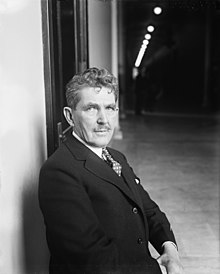Frederick Gilmer Bonfils
Frederick Gilmer Bonfils | |
|---|---|
 Bonfils in 1924
| |
| Born | December 21, 1860
Troy, Missouri, US
|
| Died | February 2, 1933 (73 years old)
Denver, Colorado, US
|
| Resting place | Fairmount Cemetery (Denver, Colorado) |
| Occupation | Newspaper Publisher |
| Relatives |
Helen Bonfils (daughter) May Bonfils Stanton (daughter) |
Frederick Gilmer Bonfils (December 21, 1860 – February 2, 1933) was an American publisher who made the The Denver Post into one of the largest newspapers in the United States.
Early life
Born in Troy, Missouri, he entered the United States Military Academy in 1878, but resigned in 1881 and went into land speculation in the Kansas, Oklahoma and Texas booms. He purchased The Denver Post with Harry Heye Tammen in 1895.
Journalism
Bonfils had met Tammen at the Windsor Hotel in Denver, where Tammen was a bartender, an editor of the Great-Divide Weekly Newspaper, as well as inauthentic Native-American memorabilia.
In December 1899, Tammen and Bonfils were shot in their office by W.W. Anderson, an attorney representing Alferd Packer, after they published an article that had accused Packer of cannabalism. In the scuffle, Bonfils was shot once in the neck, and Tammen once in the chest. Anderson was tried three times, but never convicted while Tammen and Bonfils were convicted for jury tampering in the third trial.
Bonfils took $250,000 of bribes from Harry Ford Sinclair to not report on the Teapot Dome scandal. Bonfils and Tammen both justified their style of sensationalistic journalism, as well as crediting their success as newspapermen, with the quote "a dogfight on a Denver street is more important than a war in Europe."
In 1902, Bonfils and Tammen founded the Floto Dog & Pony Show. The show was named after Otto Floto, the famous sports editor of the Denver Post, who was involved in the publicity work for the show. In 1906, when bareback rider Willie Sells joined the show, it was renamed the Sells-Floto Circus. Bonfils and Tammen owned the show until 1921, when it was one of a number of shows acquired by the American Circus Corporation.
In 1909, Bonfils and Tammen bought the Kansas City Journal-Post and owned it until selling it to Walter S. Dickey in 1922. J. Ogden Armour was a silent partner in the endeavor. The Post with its tabloid format, red headlines and yellow journalism was closely tied to the rise of the Tom Pendergast political machine in Kansas City.
Death
Bonfils died of encephalitis at his home in Denver, Colorado in 1933, and was interred in the Fairmount Mausoleum at Fairmount Cemetery, Denver. At the time of his death, he was pursuing a libel lawsuit against the Post's competitor, the Rocky Mountain News.